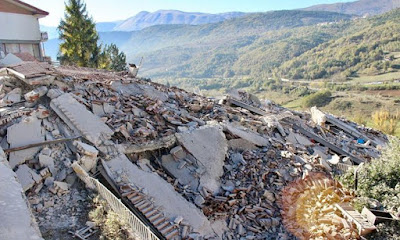The United States Geological Survey recorded a Magnitude 6.6 Earthquake at a depth of 10 km, roughly 6 km to the north of the town of Norcia in Perugia Provice in Umbria, Central Italy, at about 7.40 am local time (about 6.40 am GMT) on Sunday 30 October 2016. The Earthquake is reported to have destroyed a number of historic buildings in the area, including the historic Basilica of St Benedict in Norcia, parts of which dated back to the fourteenth century. There are no reports of any casualties from this event yet, however this is unlikely to remain the case given the number of buildings that have collapsed in the area; the United States Geological Survey is estimating that there is a 76% chance on there being more that 100 fatalities as a result of this event and a 41% chance of more than 1000 people having died. People have reported feeling the event across Italy as well as in Austria, Slovenia, Croatia and Bosnia and Herzegovina.
The remains of the historic Basilica of St Benedict in Norcia, Italy. Destroyed by an Earthquake on 30 October 2016. Cameron Sinclair/Twitter.
Historically
Italy has suffered a number of devastating Earthquakes that lead to
large numbers of casualties, though in recent decades the country has
made serious attempts to prevent this, with better warning systems and
tighter building regulations, though the large number of historic
buildings in Italy, which cannot easily be replaced (and any attempt to
do so would be unlikely to succeed due to their high cultural value),
meaning that the country is unlikely to be completely risk free any time
soon.
Collapsed building in L’Aquila, Italy, following the 30 October 2016 Earthquake. Claudio Lattanzio/EPA
Italy
is in an unusual tectonic setting, with the west of the country lying
on the Eurasian Plate, but the east of the country lying on the Adriatic
Plate, a microplate which broke away from North Africa some time in the
past and which is now wedged into the southern margin of Europe,
underlying eastern Italy, the Adriatic Sea and the west of the Balkan
Peninsula. This, combined with the northward movement of the African
Plate into Italy from the south, leads to uplift in the Apennine
Mountains that run the length of the country, and makes Italy extremely
prone to Earthquakes.
Outline map showing the approximate positions of the Eurasian (EU), Adriatic (AD) and African (AF) Plates. Di Bucci & Mazzuli (2003).
Witness
accounts of Earthquakes can help geologists to understand these events,
and the structures that cause them. The international non-profit
organisation Earthquake Report is interested in hearing from people who may have felt this event; if you felt this quake then you can report it to Earthquake Report here.
See also...

Follow Sciency Thoughts on Facebook.








